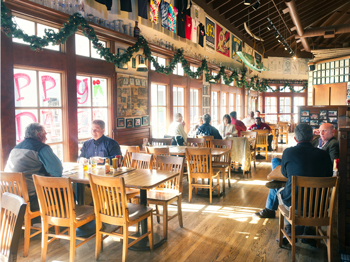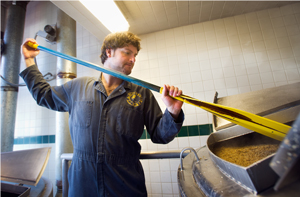Life changed for this son of Irish immigrants — born in San Francisco’s Sunset District — the day that he, as a young man, walked into a place called Buffalo Bill’s in Hayward and first discovered the brewpub concept. It was a revelation. The idea that he could do something like that himself was light-years beyond his humble beginnings as a Liquor Barn clerk and a lot less risky than the importing business, where he had just seen his boss lose everything after a change in exchange rates. It wasn’t long before Moylan started home brewing and taking brewing classes at UC Extension, always with the idea of one day opening his own place. Now, many years later, Moylan finds himself the owner of two successful Marin-based restaurant/brewpubs — Marin Brewing Company in Larkspur and Moylan’s in Novato — that employ 170 people and ship products all over the world.
How did you decide on running a brewpub as a career? I walked into Buffalo Bill’s, and I shifted away from importing and toward, Oh my god, you’ve got to make it yourself. A brewpub: What a concept — brew it, serve it, you know, the whole nine yards. Seems like a complete business model. You are able to combine a number of businesses into one. We’re a brewery, a pub, a restaurant, a distributor and a wholesaler, so we can do all those kinds of things and combine them and make the one business work. The bottled beer markets the pub, and the pub markets the bottled beer; it all balances out.
Was opening day a little scary for you? We opened Marin Brewing Company in 1989, April Fool’s Day; we were on the Narsai David show with a live radio broadcast. It wasn’t scary to open. Moylan’s [opened 6 years later] was scarier, the second one. I was a million dollars over budget on that one, thank you architect. The next one down, Noonan’s [a high-end bar and restaurant, now closed], was even scarier. With each business you open it’s like rolling the dice.
 Do you brew at both locations, and how much can you brew and serve on tap? We brew at both locations. Moylan’s was a building that we built from the ground up, so we were able to plan it a little better as far as the use factor. The brewery we built there has a capacity of around 4,000 barrels, whereas at Marin Brewing Company we can make around 2,700.
Do you brew at both locations, and how much can you brew and serve on tap? We brew at both locations. Moylan’s was a building that we built from the ground up, so we were able to plan it a little better as far as the use factor. The brewery we built there has a capacity of around 4,000 barrels, whereas at Marin Brewing Company we can make around 2,700.
In the old days we would have three to four beers on tap. Right now we usually have seven to eight on tap at Marin Brewing Company — people want more variety these days. We’ve been able to expand a little bit there and add on to some storage space, which allows us to have more beers available. Although I would like to have a lot more space.
At Moylan’s we traditionally have 18 to 20 on tap, so in that newer pub we were able to put in a little more room and have a little more beer there. I’m a big variety person. I love making lots of good beers, lots of different beers and making a beer for everybody.
Tell us about the beer and the differences between your two brewing locations. Beer-wise, what is nice at Marin Brewing Company is that we use a London ale yeast for all our standard ales, and then, when we want to make something special, we use a Belgium-style yeast and we make a number of different Belgium-style beers.
At Moylan’s, we use a Chico ale yeast for all our regular beers, and when we want to make something special we do German lagers. So between the two breweries we are making 50 to 60 beers in a given year, and they are all truly different. We might have a pale ale at Moylan’s and a pale ale at Marin Brewing Company, but they are different beers made with different yeasts, and they have different ingredients at a different brewery from a different facility, so they will taste a little different. I get people who say, “I love the Marin beers,” and others who say, “Oh, I love the Moylan beers,” and that’s great.
You can see by our display case out front that we’ve been lucky enough to win a lot of awards over the years. A lot of that has to do with the fact that we were willing to be one step ahead of a lot of people.
How does your beer fit into the culture of Marin? At Marin Brewing Company, we do lunch, dinner and late-night dining, a full menu ’til midnight every night. It really attracts a lot of people who have odd schedules, and nowadays I think more and more people have odd schedules. We get people coming from the hospital shift that is over at 11 p.m. They are in their hospital garb, they’re getting off work, they are hungry, they want a beer, they want to relax, you know, that’s their 5 o’clock. But it’s always been a meeting place where people can come. You can be sitting next to a guy with a three-piece suit and a guy with a tie-dye shirt, and the next thing you know they’ll look at each other and say, “Hey Bob, how’s it going?” It’s a great meeting place and a great place for social interaction.
How do you come up with the Marin-centric names for your beer? The first name I came up with was San Quentin’s Breakout Stout, and I got that from a guy who worked at Liquor Barn. He says, “San Quentin Breakout Stout,” and I say, “Great name for a beer.” Another one I can remember naming is the Old Dipsea Barley Wine, because, traditionally, barley wines are “old” something. I was looking at the chalkboard with a space where the name should be, and someone yelled from the bar, “Dipsea,” and I thought, Dipsea… like tipsy, like drinking. Dipsea, Marin County, perfect.
We also have Cuvee Roge, Roge being one of our managers. Her name is perfect. Arne [the brewmaster] came up with it, and it was like, “That’ll work.” Roge is one of our girls; now she has a beer named after her. Some of the other people are a little jealous. If you’re smart, you submit a suggestion with your name in it. I of course do the St. Brendan’s, because we all know how saintly Brendan is. There’s a lot of poetic freedom in a business like this, and the stuff you can put on a beer label — we have a lot of fun with it.
How soon after opening the brewpub did you get into bottling and distribution? We bottled pretty quickly into the business. About two years in, we started bottling the Mt. Tam Pale Ale. After that we bottled the Albion Amber, the Marin Weiss and the Old Dipsea Barley Wine. Barley wines are supposed to come out in a little seven-ounce nip, but we did a 22-ounce barley wine. Traditional brewer types would give us an evil look. But my bottling machine could only fit one size of bottle, so tough luck, that’s what you get.
We ship the Marin Brewing Company beers to Oregon and Arizona and throughout California. The Moylan’s beers ship to about 30 states and several countries, including England, Denmark, Guam, Puerto Rico, New Zealand, Australia and Japan — the Japanese go crazy for the microbrewed beers; they love them.
 Who is your brewmaster? Grant Johnston was our first brewer. Now Arne Johnson has been here the last 15 or 16 years. He originally apprenticed here through a UC Davis Extension class, and he was good. When Grant was going to leave, Arne stepped right in and filled his shoes, and he has been going full steam ever since. He does his job really well and is very respected within the brewers’ community, and the customers really like his beer. It is a big responsibility to be the man. My job is to hire the right guy and give him everything I can to make him successful. He’s kind of got the job I want. But I’m doing pretty good; I can’t complain — it’s a fun business.
Who is your brewmaster? Grant Johnston was our first brewer. Now Arne Johnson has been here the last 15 or 16 years. He originally apprenticed here through a UC Davis Extension class, and he was good. When Grant was going to leave, Arne stepped right in and filled his shoes, and he has been going full steam ever since. He does his job really well and is very respected within the brewers’ community, and the customers really like his beer. It is a big responsibility to be the man. My job is to hire the right guy and give him everything I can to make him successful. He’s kind of got the job I want. But I’m doing pretty good; I can’t complain — it’s a fun business.
Describe your ideal Northern California beer tour. The Highway 101 tour of breweries is fantastic. If I’m doing the 101 tour, I’m doing Marin Brewing Company, Moylan’s, Lagunitas, Third Street, Russian River, Bear Republic, Mendocino, Hopland and Boonville; that’s a hell of a ride. Then skip over the coast to hit North Coast Brewing Company. It will take more than one day: maybe two breweries a day is a good pace — a lunch one and a dinner one and leave it at that.
What are your future plans? I have a business I am running with my father; it’s a distillery up in Petaluma, where we are making whiskeys. The Moylan’s Distilling Company whiskeys will be out hopefully in the next couple of months. It’s a fun business. After you become a mad-scientist brewer, the next thing is distilling. If you can ferment it, you can distill it. I’m really enjoying it and looking forward to it; whiskey is something you have to wait around for. It takes a long time.


